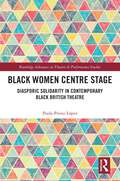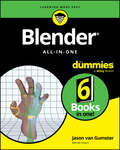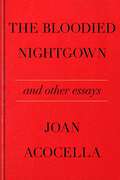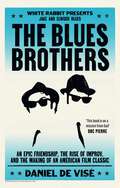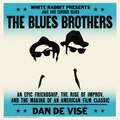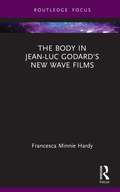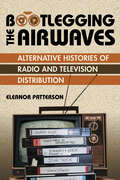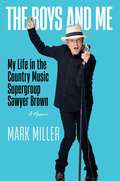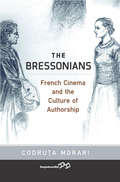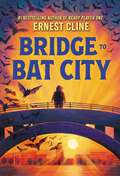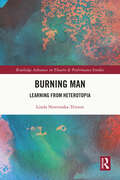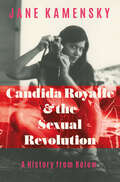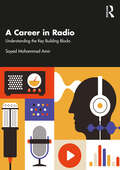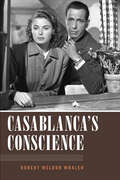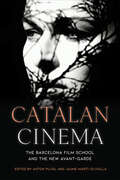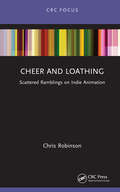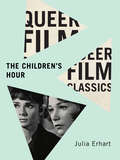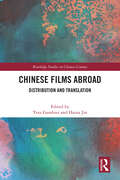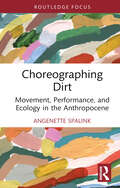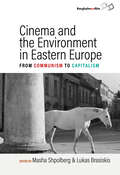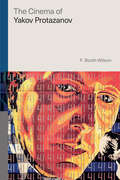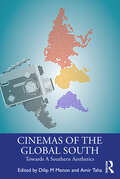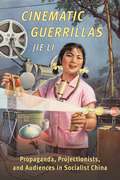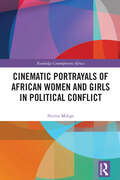- Table View
- List View
Black Women Centre Stage: Diasporic Solidarity in Contemporary Black British Theatre (Routledge Advances in Theatre & Performance Studies)
by Paola Prieto LópezThis book examines the political alliances that are built across the diaspora in contemporary plays written by Black women playwrights in the UK. Through the concept of creative diasporic solidarity, it offers an innovative theoretical approach to examine the ways in which the playwrights respond creatively to the violence and marginalisation of Black communities, especially Black women. This study demonstrates that theatre can act as a productive space for the ethical encounter with the Other (understood in terms of alterity, as someone different from the self) by examining the possibilities of these plays to activate the spectators’ responsibility and solidarity towards different types of violence experienced by Black women, offering alternative modes of relationality. The book engages with a range of contemporary works written by Black women playwrights in the UK, including Mojisola Adebayo, Theresa Ikoko, Diana Nneka Atuona, Gloria Williams, Charlene James, or Yusra Warsama, bringing to the fore a gendered and intersectional approach to the analysis of the texts. This book will be of great interest to students and scholars in contemporary theatre, gender studies and diaspora studies.
Blender All-in-One For Dummies
by Jason van GumsterCreate excellent 3D animations with free, open-source software When you’re looking for help with creating animation with Blender, look no further than the top-selling Blender book on the market. This edition of Blender For Dummies covers every step in the animation process, from basic design all the way to finished product. This book walks you through each project phase, including creating models, adding lighting and environment, animating objects, and building a final shareable file. Written by long-time Blender evangelist Jason van Gumster, this deep reference teaches you the full animation process from idea to final vision. With this fun and easy guide, you’re on your way toward making your animation dreams a reality. Set up Blender and navigate the interface Learn how to build models in virtual space Texture, light, and animate your figures—then render your final product Get help and inspiration from the Blender community If you’re new to Blender or an experienced user in need of a reference, Blender For Dummies is the easy-to-use guide for you.
The Bloodied Nightgown and Other Essays
by Joan AcocellaA collection of the New Yorker critic's finest essays, which examine the books that reveal and record our world.Joan Acocella was “one of our finest cultural critics” (Edward Hirsch), and she had the rare ability to examine literature and unearth the lives contained within it—its authors, its subjects, and the communities from which it springs. In her hands, arts criticism was a celebration and an investigation, and her essays pulse with unadulterated enthusiasm. As Kathryn Harrison wrote in The New York Times Book Review, “Hers is a vision that allows art its mystery but not its pretensions, to which she is acutely sensitive. What better instincts could a critic have?”The Bloodied Nightgown and Other Essays gathers twenty-four essays from the final decade and a half of Acocella’s career, as well as an introduction that frames her simple preoccupations: “life and art.” In agile, inspired prose, she moves from J. R. R. Tolkien’s translation of Beowulf to the life of Richard Pryor, from surveying profanity to untangling the book of Job. Her appetite (and reading list) knew no bounds. This collection is a joy and a revelation, a library in itself, and Acocella is our dream companion among its shelves.Includes 25 black-and-white images
The Blues Brothers: An Epic Friendship, the Rise of Improv, and the Making of an American Film Classic
by Daniel de ViséThe Blues Brothers hit theatres on June 20, 1980. Their scripted mission was to save a local Chicago orphanage; but Aykroyd, who conceived and wrote much of the film, had a greater mission: to honour the then-seemingly forgotten tradition of rhythm and blues, some of whose greatest artists - Aretha Franklin, James Brown, John Lee Hooker, Cab Calloway, Ray Charles - made the film as unforgettable as its wild car chases. Much delayed and vastly over budget, beset by mercurial and oft drugged-out stars, The Blues Brothers opened to outraged reviews. However, in the 44 years since it has been acknowledged a classic: inducted into the National Film Registry for its cultural significance, even declared a 'Catholic classic' by the Church itself, and re-aired thousands of times on television to huge worldwide audiences. It is, undeniably, one of the most significant films of the 20th century.The saga behind The Blues Brothers, as Daniel de Visé reveals, is epic, encompassing the colourful childhoods of Belushi and Aykroyd; the comedic revolution sparked by Harvard's Lampoon and Chicago's Second City; the birth and anecdote-rich, drug-filled early years of Saturday Night Live, where the Blues Brothers were born as an act amidst turmoil and rivalry; and, of course, the indelible behind-the-scenes narrative of how the film was made, scene by memorable scene. Based on original research and dozens of interviews probing the memories of principals from director John Landis and producer Bob Weiss to Aykroyd himself, The Blues Brothers illuminates an American masterpiece while vividly portraying the creative geniuses behind modern comedy.
The Blues Brothers: An Epic Friendship, the Rise of Improv, and the Making of an American Film Classic
by Daniel de ViséThe Blues Brothers hit theatres on June 20, 1980. Their scripted mission was to save a local Chicago orphanage; but Aykroyd, who conceived and wrote much of the film, had a greater mission: to honour the then-seemingly forgotten tradition of rhythm and blues, some of whose greatest artists - Aretha Franklin, James Brown, John Lee Hooker, Cab Calloway, Ray Charles - made the film as unforgettable as its wild car chases. Much delayed and vastly over budget, beset by mercurial and oft drugged-out stars, The Blues Brothers opened to outraged reviews. However, in the 44 years since it has been acknowledged a classic: inducted into the National Film Registry for its cultural significance, even declared a 'Catholic classic' by the Church itself, and re-aired thousands of times on television to huge worldwide audiences. It is, undeniably, one of the most significant films of the 20th century.The saga behind The Blues Brothers, as Daniel de Visé reveals, is epic, encompassing the colourful childhoods of Belushi and Aykroyd; the comedic revolution sparked by Harvard's Lampoon and Chicago's Second City; the birth and anecdote-rich, drug-filled early years of Saturday Night Live, where the Blues Brothers were born as an act amidst turmoil and rivalry; and, of course, the indelible behind-the-scenes narrative of how the film was made, scene by memorable scene. Based on original research and dozens of interviews probing the memories of principals from director John Landis and producer Bob Weiss to Aykroyd himself, The Blues Brothers illuminates an American masterpiece while vividly portraying the creative geniuses behind modern comedy.
The Blues Brothers: An Epic Friendship, the Rise of Improv, and the Making of an American Film Classic
by Daniel de ViséThe Blues Brothers hit theatres on June 20, 1980. Their scripted mission was to save a local Chicago orphanage; but Aykroyd, who conceived and wrote much of the film, had a greater mission: to honour the then-seemingly forgotten tradition of rhythm and blues, some of whose greatest artists - Aretha Franklin, James Brown, John Lee Hooker, Cab Calloway, Ray Charles - made the film as unforgettable as its wild car chases. Much delayed and vastly over budget, beset by mercurial and oft drugged-out stars, The Blues Brothers opened to outraged reviews. However, in the 44 years since it has been acknowledged a classic: inducted into the National Film Registry for its cultural significance, even declared a 'Catholic classic' by the Church itself, and re-aired thousands of times on television to huge worldwide audiences. It is, undeniably, one of the most significant films of the 20th century.The saga behind The Blues Brothers, as Daniel de Visé reveals, is epic, encompassing the colourful childhoods of Belushi and Aykroyd; the comedic revolution sparked by Harvard's Lampoon and Chicago's Second City; the birth and anecdote-rich, drug-filled early years of Saturday Night Live, where the Blues Brothers were born as an act amidst turmoil and rivalry; and, of course, the indelible behind-the-scenes narrative of how the film was made, scene by memorable scene. Based on original research and dozens of interviews probing the memories of principals from director John Landis and producer Bob Weiss to Aykroyd himself, The Blues Brothers illuminates an American masterpiece while vividly portraying the creative geniuses behind modern comedy.
The Body in Jean-Luc Godard's New Wave Films (Routledge Focus on Film Studies)
by Francesca Minnie HardyThis original study examines the representation of the body in French New Wave films through discussion of a series of films by Jean-Luc Godard, perhaps the central figure of the French New Wave. Through analysis of À bout de souffle, Une femme est une femme, Le Mépris and Alphaville, alongside discussion of some of Godard’s lesser-known French New Wave films, the book explores the interrelation between bodies, books and bathrooms that they facilitate. In so doing, it aims to destabilise the French New Wave’s myth of male exceptionalism and denaturalise the gender dynamic most commonly viewed at its heart, revealing that the women who make up a fundamental part of its fabric are not textually trapped by Godard’s authorial presence. Instead, their corporeality disrupts any purported authorial and national ownership of their bodies. Given the enduring popularity and visibility of the French New Wave, and of Jean-Luc Godard, in universities and journals, The Body in Jean-Luc Godard’s New Wave Films will appeal to scholars in the disciplines of French and film studies, as well as to undergraduate and postgraduate students of these disciplines.
Bootlegging the Airwaves: Alternative Histories of Radio and Television Distribution (The History of Media and Communication)
by Eleanor PattersonHow fan passion and technology merged into a new subculture Long before internet archives and the anytime, anywhere convenience of streaming, people collected, traded, and shared radio and television content via informal networks that crisscrossed transnational boundaries. Eleanor Patterson’s fascinating cultural history explores the distribution of radio and TV tapes from the 1960s through the 1980s. Looking at bootlegging against the backdrop of mass media’s formative years, Patterson delves into some of the major subcultures of the era. Old-time radio aficionados felt the impact of inexpensive audio recording equipment and the controversies surrounding programs like Amos ‘n’ Andy. Bootlegging communities devoted to buddy cop TV shows like Starsky and Hutch allowed women to articulate female pleasure and sexuality while Star Trek videos in Australia inspired a grassroots subculture built around community viewings of episodes. Tape trading also had a profound influence on creating an intellectual pro wrestling fandom that aided wrestling’s growth into an international sports entertainment industry.
The Boys and Me: My Life in the Country Music Supergroup Sawyer Brown
by Mark MillerThe Boys and Me is the behind-the-scenes, untold story of front man and lead singer Mark Miller and his band—country music icons Sawyer Brown!Before The Voice and American Idol, there was Star Search with Ed McMahon. In the first season, an eclectic and charismatic country-rock band called Sawyer Brown appeared on the show, taking America by storm. From ignored underdogs in Nashville to overnight rock stars from LA to New York, they swept the competition and won. Since 1984, &“the boys&” legendary live shows, along with their relentless drive to stay true to themselves, have captivated faithful fans around the world. As front man and lead singer of the band, Mark Miller&’s rise to fame wasn&’t exactly the path he envisioned for himself. After losing his father, Mark was raised by his mom whose solid faith and strong work ethic helped guide and shape him and his brother, Frank. With his sights set on playing pro basketball, Mark never dreamed of becoming an entertainer, especially considering he was terrified to stand on a stage. But God had a different plan. Now, forty years later, Sawyer Brown has eighteen studio albums to their name, multiple No. 1 singles, fifty-plus songs charting on the Billboard Hot Country Songs, and legendary award-winning videos. And they have no plans of stopping any time soon. The band&’s longevity is a testament to their strong songwriting, high-energy performances, and hard work. This is the behind-the-scenes, untold story of Mark Miller and &“the boys&”—country music icons Sawyer Brown!
The Bressonians: French Cinema and the Culture of Authorship
by Codruţa MorariHow should we understand film authorship in an era when the idea of the solitary and sovereign auteur has come under attack, with critics proclaiming the death of the author and the end of cinema? The Bressonians provides an answer in the form of a strikingly original study of Bresson and his influence on the work of filmmakers Jean Eustache and Maurice Pialat. Extending the discourse of authorship beyond the idea of a singular visionary, it explores how the imperatives of excellence function within cinema’s pluralistic community. Bresson’s example offered both an artistic legacy and a creative burden within which filmmakers reckoned in different, often arduous, and altogether compelling ways.
Bridge to Bat City
by Ernest ClineFrom #1 New York Times bestselling author Ernest Cline comes a mostly true tall tale about an unexpected friendship between a young girl and a music-loving colony of bats. After losing her mother, thirteen-year-old Opal moves in with her uncle Roscoe on the family farm. There, Opal bonds with Uncle Roscoe over music and befriends a group of orphaned, music-loving bats. But just as the farm is starting to feel like home, the bats&’ cave is destroyed by a big mining company with its sights set on the farmland next. If Opal and the bats can fit in anywhere, it&’s the nearby city of Austin, home to their favorite music and a host of wonderfully eccentric characters. But with people afraid of the bats and determined to get rid of them, it&’ll take a whole lot of courage to prove that this is where the bats—and Opal—belong.
Burning Man: Learning from Heterotopia (Routledge Advances in Theatre & Performance Studies)
by Linda Noveroske-TrittenThis book centres on a philosophical analysis of creative acts in the Burning Man Festival and their roles in wider social change. With particular focus on the Ten Principles of Burning Man, Linda Noveroske posits a re-interpretation of common notions of “self” and “other” as they apply to identity, difference, and the ways that these personal impulses ripple outward from changing individuals into changing societies. Such radical re-imagination of ideology can be most powerful when it occurs in spaces of otherness, of heterotopia. This study casts Burning Man as a heterotopia to not only destabilizes what we think we know about visual art, performance, and creative encounters, but also bring these acts into an attitude of immediacy that facilitates previously unimagined behaviour and opens out artistic drive into the unknown. This book would be of value for scholars and practitioners in Performance Studies, Theatre and Dance, Art History, Psychology, Phenomenology, Architecture and Urban Studies.
Candida Royalle and the Sexual Revolution: A History from Below
by Jane KamenskyAcclaimed historian Jane Kamensky chronicles an indelible twentieth-century American life—and offers an entirely new understanding of the so-called sexual revolution. Whether in front of the camera or behind it, Candice Vadala understood herself as both an artist and an entrepreneur. As Candida Royalle (1950–2015)—underground actress, porn star, producer of adult movies, and staunch feminist—she made a business of pleasure. She helped crystalize the broader hedonistic turn in American life in the second half of the twentieth century: a period when the rules of sex were rewritten; when the white-hot “sex wars” cleaved feminism and realigned American politics; when Big Freud, Big Drugs, and Big Porn all came into looming focus; when the sex industry of the 1970s and ’80s radically upended conventional understandings of law, technology, culture, love, and human desire. The sexual revolution was Royalle’s war—even when other avowed feminists exited the field or became her opponents—and pornography emerged as the arena in which she would wage it. With the founding of her adult film company, Femme Productions, in 1984, Royalle became an owner of the means of pornographic production, infusing her sets with the ideals of labor feminism. On-screen and off-, she was, by turns, exuberant and thoughtful, self-possessed and gleefully shameless. A trailblazer who lived along the cultural fault lines of her generation, she danced at Woodstock, marched for women’s liberation, survived the AIDS crisis, and became a talk show regular, interviewed by Phil Donahue, Dr. Ruth Westheimer, Morton Downey Jr., Jane Pauley, and many others. As a performer, director, producer, and writer, she moved the needle of her industry. But she never transcended the politics of pleasure. With full access to Royalle’s remarkable archive, historian Jane Kamensky has spent years examining the intersection of Royalle’s life with the clashes that have defined her era—and ours. Deeply informed by these never-before-studied materials, Kamensky explodes the conventions of biography, with its assumptions about who makes history and how. Written with cinematic verve, Candida Royalle and the Sexual Revolution evokes Royalle’s times in their broadest contours as Kamensky traces the rise of an improbable heroine who broke the mold and was herself broken in turn.
A Career in Radio: Understanding the Key Building Blocks
by Sayed Mohammad AmirThis book gives an overview of the development, significance, and impact of radio as a medium of mass communication in modern society. It provides a thorough understanding of the various wings and functionaries of the radio industry. The book also covers aspects of commercial radio, the basics of understanding the pulse of radio listeners, formatting radio programming, making an effective sales pitch and producing great commercials to exhaustive advice on presenting a show, appearing for interviews, and public speaking. It also gives insight into the changes brought in by technology in terms of traditional radio broadcasts, such as digital radio, highlighting its advancements in audio quality and the diversity of programming options available, and satellite radio, subscription-based services, and exclusive access to specialised programming. An outcome of the author’s vast experience of working as a radio jockey and programme manager for over 17 years, his book will be an ideal textbook for undergraduate and postgraduate students of journalism and mass communication, taking courses on radio, audio and podcasting, media production and digital media. Additionally, this book will be an invaluable companion to existing radio professionals as a resource-book for their professional development.
Casablanca's Conscience
by Robert Weldon WhalenA new look at a beloved classic film that explores the philosophical dynamics of CasablancaCelebrating its eightieth anniversary this year, Casablanca remains one of the world’s most enduringly favorite movies. It won three Academy Awards for Best Picture, Best Director, and Best Adapted Screenplay. It is still commonly quoted: “We’ll always have Paris” and “Here’s looking at you, kid” And who can forget, “You must remember this…a kiss is just a kiss.” Yet no one expected much to come of this little film, certainly not its blockbuster stars or even the studio producing it. So how did this hastily cranked-out 1940s film, despite its many limitations, become one of the greatest films ever made? How is it that year after year, decade after decade, it continues to appear in the lists of the greatest movies ever produced? And why do audiences still weep when Rick and Ilsa part? The answer, according to Casablanca’s Conscience, is to paraphrase Rick, “It’s true.”Much has already been written about the film and the career-defining performances of Bogart and Bergman. Casablanca is an epic tale of love, betrayal, and sacrifice set against the backdrop of World War II. Yet decades later, it continues to capture the imagination of filmgoers. In Casablanca’s Conscience, author Robert Weldon Whalen explains why it still resonates so deeply. Applying a new lens to an old classic, Whalen focuses on the film’s timeless themes—Exile, Purgatory, Irony, Love, Resistance, and Memory. He then engages the fictional characters—Rick, Ilsa, and the others—against the philosophical and theological discourse of their real contemporaries, Hannah Arendt, Dietrich Bonhoeffer, and Albert Camus. The relationships between fictional and historical persons illuminate both the film’s era as well as perennial human concerns. Both the film and the work of the philosophers explore dimensions of the human experience, which, while extreme, are familiar to everyone. It’s the themes that resonate with the viewer, that have sustained it as an evergreen classic all these years.
Catalan Cinema: The Barcelona Film School and the New Avant-Garde (Toronto Iberic)
by Anton Pujol Jaume Martí-OlivellaCatalan Cinema offers a theoretical reading of the most relevant cinematic productions to emerge from Catalonia in the last twenty years. The essays in this collection examine cinema in relation to the Escola de Barcelona (The Barcelona School), a group of cinema directors that drew inspiration from British pop-art, Free Cinema, and the Nouvelle Vague to create works that defied and challenged the Franco dictatorship. Highlighting the aesthetic, social, and political elements of Catalan cinematography, contributors to this volume explore what young directors have in common with works created by more notable directors such as Joaquim Jordà, Jacinto Esteva, Jordi Grau, and Pere Portabella. Catalan Cinema focuses on the importance of modern production and its connection with the avant-garde and underground cinema from the Barcelona School. Establishing a cinematic genealogy, the volume ultimately questions if Catalan cinema’s own push for self-expression may be interpreted as a connection to Catalonia’s current drive for independence.
Cheer and Loathing: Scattered Ramblings on Indie Animation (Focus Animation Ser.)
by Chris RobinsonOne of the most acclaimed writers in animation returns with this informal sequel to his previous books on indie animation, Unsung Heroes of Animation, Animators Unearthed, and Mad Eyed Misfits. In this collection, award-winning writer, Chris Robinson, looks at a wide range of films, topics (sex, censorship, cultural politics, programming, felt, gifs, VR, dogs) and filmmakers (Masaaki Yuasa, Xi Chen, Gil Alkabetz, Jacques Drouin, Bordo, Rosto, Joaquín Cociña, Cristóbal León, George Schwizgebel, Lizzy Hobbs, Andreas Hykade, Leah Shore, and many others). Eclectic, brief, fiery, and opinionated, Robinson’s gonzo-tinged writing will amuse, confuse, annoy, and maybe even inspire while, hopefully introducing readers to the wonders of independently-produced animation.
The Children’s Hour (Queer Film Classics #10)
by Julia ErhartBased on a play by Lillian Hellman, The Children’s Hour (1961) was the first mainstream commercial American film to feature a lesbian character in a leading role. It centres on a teacher at a girls’ school (Shirley MacLaine) who is accused of harbouring feelings for her co-worker (Audrey Hepburn) and depicts the intense moral panic that ensues. Produced in the social climate of the Lavender Scare, the film reveals deep insights into the politics of sexuality and censorship in midcentury America, only a few years before more visible struggles for queer liberation.The director, William Wyler, lobbied hard to get the film made after an earlier straight-washed version in 1936. The tense road to production included debates about whether to eliminate mentions of lesbianism from the script and how implicitly queer subject matter might conflict with the Production Code, by then weakened but still in force. Julia Erhart’s reading of the film’s conception, production, and reception advances a nuanced case of censorship as a productive force. While contests between Hellman and Wyler suppressed scenes of overt affection between main characters Karen and Martha, reception was comparatively fixated on the characters’ lesbianism: it threatened middlebrow movie critics in the mainstream press and resonated with queer audiences. Erhart’s attentive interpretation of both the script and the sonic landscape yields a detailed analysis of the soundtrack as an original pro-lesbian element.As issues of queer censorship continue to permeate life and culture more than fifty years later, Erhart demonstrates that The Children’s Hour is as salient to social and political tensions around gender and sexuality today as it was in the 1960s.
Chinese Films Abroad: Distribution and Translation (Routledge Studies in Chinese Cinema)
by Yves Gambier Haina JinThis book examines Chinese films made and shown abroad roughly between the 1920s and the 2020s, from the beginning of the international exchange of the Chinese national film industry to the emergence of the concept of soft power.The periodisation of Chinese cinema(s) does not necessarily match the political periods: on the one hand, the technical development of the film industry and the organisation of translation in China, and on the other hand, official relations with China and translation policies abroad impose different constraints on the circulation of Chinese films. This volume deals with the distribution and translation of films from mainland China, Taiwan, Hong Kong, and the Chinese diaspora. To this end, the contributors address various issues related to the circulation and distribution of Chinese films, including co- productions, agents of exchange, and modes of translation. The approach is a mixture of socio- cultural and translational methods. The data collected provides, for the first time, a quantitative overview of the circulation of Chinese films in a dozen foreign countries.The book will greatly interest scholars and students of Chinese cinema, translation studies, and China studies.
Choreographing Dirt: Movement, Performance, and Ecology in the Anthropocene (Routledge Studies in Theatre, Ecology, and Performance)
by Angenette SpalinkThis book is an innovative study that places performance and dance studies in conversation with ecology by exploring the significance of dirt in performance. Focusing on a range of 20th- and 21st-century performances that include modern dance, dance-theatre, Butoh, and everyday life, this book demonstrates how the choreography of dirt makes biological, geographical, and cultural meaning, what the author terms "biogeocultography". Whether it’s the Foundling Father digging into the earth’s strata in Suzan-Lori Park’s The America Play (1994), peat hurling through the air in Pina Bausch’s The Rite of Spring (1975), dancers frantically shovelling out fistfuls of dirt in Eveoke Dance Theatre’s Las Mariposas (2010), or Butoh performers dancing with fungi in Iván-Daniel Espinosa’s Messengers Divinos (2018), each example shows how the incorporation of dirt can reveal micro-level interactions between species – like the interplay between microscopic skin bacteria and soil protozoa – and macro-level interactions – like the transformation of peat to a greenhouse gas. By demonstrating the stakes of moving dirt, this book posits that performance can operate as a space to grapple with the multifaceted ecological dilemmas of the Anthropocene. This book will be of broad interest to both practitioners and researchers in theatre, performance studies, dance, ecocriticism, and the environmental humanities.
Cinema and the Environment in Eastern Europe: From Communism to Capitalism
by Masha Shpolberg and Lukas BrasiskisThe annexation of Eastern Europe to the Soviet sphere after World War II dramatically reshaped popular understandings of the natural environment. With an eco-critical approach, Cinema and the Environment in Eastern Europe breaks new ground in documenting how filmmakers increasingly saw cinema as a tool to critique the social and environmental damage of large-scale projects from socialist regimes and newly forming capitalist presences. New and established scholars with backgrounds across Europe, the United States, and Australia come together to reflect on how the cultural sphere has, and can still, play a role in redefining our relationship to nature.
The Cinema of Yakov Protazanov (Global Film Directors)
by F. Booth WilsonBest known for Aelita (1924), the classic science-fiction film of the Soviet silent era, Yakov Protazanov directed over a hundred films in a career spanning three decades. Called "the Russian D.W. Griffith" in the 1910s for his formative role in the first movies in the last years of the Russian Empire, he fled the Civil War and maintained a successful career in Europe before making an unusual decision to return to Russia now under Soviet power. There his films continued their remarkable success with audiences undergoing a bewildering and often brutal revolutionary transformation. Rather than treating him as an indistinct, if capable craftsman, The Cinema of Yakov Protazanov argues that his films are suffused with a unique creative vision that reflects both his mindset as a traditional Russian intellectual and his experience of dislocation and migration after 1917. As he adapted his films to revolutionary culture, they intermingled different voices and reinterpreted his past work from a disavowed era. Offering fresh perspectives of Protazanov’s films, the book will give readers a new appreciation of his career. The book offers a uniquely valuable vantage point from which to explore how cinema reflected a society in transformation and a seminal moment in the development of cinematic art.
Cinemas of the Global South: Towards a Southern Aesthetics
by Dilip M Menon Amir TahaThis book engages with the idea of the Global South through cinema as a concept of resistance; as a space of decolonialisation; and as an arena of virtuality, creativity and change. It opens up a dialogue amongst scholars and filmmakers from the Global South: India, Nigeria, Colombia, Brazil, South Africa, and Egypt.The essays in the volume approach cinema as an intertwined process of both production and perception not divorced from the economic, social, political and cultural. They emphasise film as a visual medium where form, structure and content are not separable. Through a wide array of film-readings, the authors explore the concept of a southern cinematic esthetics, in particular, and the concept of the Global South in general.The volume will be of interest to scholars, students and researchers of film and media studies, critical theory, cultural studies and Global South studies.
Cinematic Guerrillas: Propaganda, Projectionists, and Audiences in Socialist China
by Jie LiHow might cinema make revolution and mobilize the masses? In socialist China, the film exhibition network expanded from fewer than six hundred movie theaters to more than a hundred thousand mobile film projectionist teams. Holding screenings in improvised open-air spaces in rural areas lacking electricity, these roving projectionists brought not only films but also power generators, loudspeakers, slideshows, posters, live performances, and mass ritual participation, amplifying the era’s utopian dreams and violent upheavals.Cinematic Guerrillas is a media history of Chinese film exhibition and reception that offers fresh insights into the powers and limits of propaganda. Drawing on a wealth of archives, memoirs, interviews, and ethnographic fieldwork, Jie Li examines the media networks and environments, discourses and practices, experiences and memories of film projectionists and their grassroots audiences from the 1940s to the 1980s. She considers the ideology and practice of “cinematic guerrillas”—at once denoting onscreen militants, off-the-grid movie teams, and unruly moviegoers—bridging Maoist iconography, the experiences of projectionists, and popular participation and resistance. Li reconceptualizes socialist media practices as “revolutionary spirit mediumship” that aimed to turn audiences into congregations, contribute to the Mao cult, convert skeptics of revolutionary miracles, and exorcize class enemies.Cinematic Guerrillas considers cinema’s meanings for revolution and nation building; successive generations of projectionists; workers, peasants, and soldiers; women and ethnic minorities; and national leaders, local cadres, and cultural censors. By reading diverse, vivid, and often surprising accounts of moviegoing, Li excavates Chinese media theories that provide a critical new perspective on world cinema.
Cinematic Portrayals of African Women and Girls in Political Conflict (Routledge Contemporary Africa)
by Norita MdegeThis book provides an interdisciplinary exploration of the cinematic representations of the experiences of African women and girls in situations of political conflict. The role of cinema is important in providing information about the situation of women and girls in situations of political conflict, and the main characters often also become signifiers of wider social, political and economic ideas, at both global and local levels. Drawing on fictional and biographical cinematic representations, this book considers films covering a range of different regions, experiences, historical periods and other contexts, to draw a nuanced picture of African women and girls who participate in or are affected by African political conflicts. The films are analysed using a decolonial feminist cultural approach, which combines cultural approaches, African feminisms and the contrapuntal method to ensure an inter-textual, intersectional and decolonial examination. The book engages with multiple themes and topics, including nationalism, nation-building, neocolonialism, memory, history, women’s and girls’ agency and activism. Through these themes and topics, the book explores how the films represent African women’s and girls’ agency in relation to their participation in social, economic and political activities. This book will make a significant contribution to literature focused on African women and girls within politics, conflict studies and film studies.
